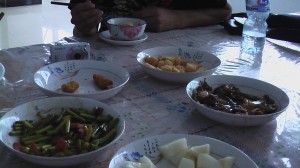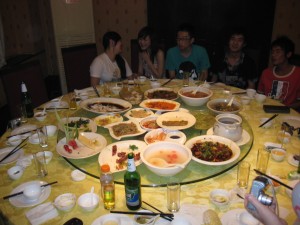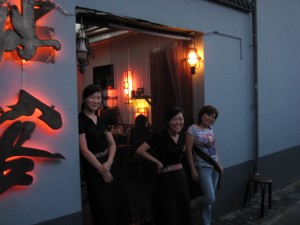Table Manners (桌子礼节) Posted by Stephen on May 29, 2011 in Culture

While most people that first visit China are shocked at the lack of proper etiquette when sitting down for a meal–don’t fool yourself–China has very particular table manner rules or 桌子礼节 (zhuōzi lǐjié). Unlike western eating culture, which espouses notions of individual servings, and stoic propriety, Chinese eating culture is all about the mixing and sharing of everything–from food to drinks to conversation and laughs. A Chinese meal is truly a social enterprise.
Almost all Chinese meals are family style, so be willing to bump elbows, share trays and even get a little messy. You’ll find that ordering food, much like everything in China, is another lesson in “bargaining” as you and your party decide what different dishes you want to get for the entire group. It’s great on two levels because you get to both share your favorite dishes (and introduce them to others), or you get to try something new that you wouldn’t ordinarily eat.
Finding “Your” Restaurant (发现你的餐厅):
Picking a restaurant is just as important as picking your dishes, so make sure you try a variety of different restaurants before you land upon what will become a daily haunt. Signs of a good Chinese restaurant are rather basic: crowded at any hour, raucous noise emanating from the inside, smiling faces greeting you outside, and of course…the delicious aromas wafting throughout the street.
Upon entering a restaurant, you may find yourself questioning the quality, and atmosphere of the restaurant, but remember looks can be deceiving. Many foreigners have been a little taken aback by the cleanliness of most restaurants, and I’ll admit health codes in China are rather low. But, to put you at ease, the food itself is usually very clean, and like most Chinese food, well-cooked to prevent illness. In my experience, a place that is a little sparse or dirty on the inside, usually makes up for their interior by having exceptional food.
Table Manners (桌子礼节):
Anyway, once you do sit down to a meal at a Chinese restaurant, here are some table manners to guide you through your meal:
The first step: learn how to use chopsticks (筷子 kuàizi). Chinese food is meant to be eaten with chopsticks. They’re perfect for grabbing and clutching tiny chunks of meat/veggies/tofu from a slow-moving lazy susan. Second, don’t rub your chopsticks together (if they’re wooden) to clean or remove splinters in sight of the owners. If you have to do it, do it under the table as a sign of respect. Third, never leave your chopsticks sticking out of your bowl, plate, rice or food like two rabbit ears. It is insulting on two levels that I know of: it resembles a rabbit and can be on par with calling someone a son of a rabbit (小兔崽子)(an insult among family) or the more blatant offense, it resembles Chinese incense that are used to honor the deceased.
Once you’ve conquered chopsticks, get used to eating out of a small bowl or 碗 (wǎn) and a small plate or 盘子 (pánzi) and drinking out of a small glass or 杯子 (bēizi). As mentioned before Chinese food is almost always family style, yet these small articles are yours and yours alone. In the bowl or plate you’re usually given a side of starch (rice, noodles, or a bun), but for the main courses you pick and choose little bits of it and eat it over your bowl or plate. Often times, rice or noodles are not eaten until the person is nearly full, as it is a “filler” for the tasty entrees.As for drinks, bottles of beer, cola, water are communal and are poured into your individual 杯子 by yourself (or often your friend will) when your glass is empty–but the remaining bottle goes back in the center of the table. For more on Chinese drinking etiquette and culture, click here to read, Cheers: Drinking Culture in China (干杯).
 Now that you’ve mastered eating utensils, you can familiarize yourself with a lazy-susan or 大专盘 (dà zhuàn pán). It’s a large, rotating, circular plate in the middle of the table where all communal food and drinks are placed. Keep in mind, the lazy-susan should only be rotated in one direction, and remember not to rotate it quickly or spin it while other are still taking bits from the plate. Here patience (耐心 nàixīn) is paramount.
Now that you’ve mastered eating utensils, you can familiarize yourself with a lazy-susan or 大专盘 (dà zhuàn pán). It’s a large, rotating, circular plate in the middle of the table where all communal food and drinks are placed. Keep in mind, the lazy-susan should only be rotated in one direction, and remember not to rotate it quickly or spin it while other are still taking bits from the plate. Here patience (耐心 nàixīn) is paramount.
Finally, it’s time to talk about how you hold conduct yourself around the table. Chinese people are more relaxed at the dinner table–a quality I wish would spread to western eating culture. As a result, bodily noises and typical western dining faux pa’s are either ignored or even reveled in at the Chinese dinner table.Belching, slurping (which you cannot avoid hearing if you go to a Chinese restaurant), smoking, being loud, clapping and yelling are all socially accepted and promoted. Chinese people slurp their meals because it’s easy to do so with chop sticks. Belching can be seen as a compliment to the cooks, demonstrating your eagerness to wolfed down the delicious meal (I personally excel at this compliment).
Smoking, drinking, being loud and boisterous are just cultural norms of Chinese drinking/dining culture. It’s not really looked down upon to go out and chain smoke and drink with your boss and coworkers. As for dealing with waiters/waitresses or 服务员, service in China is rather lacking. If you want something amidst a boisterous, crowded and bustling restaurant, it’s up to you to signal the fuwuyuan’s attention, simply by yelling “服务员”. It’s not impolite and honestly that kind of service grows on you if you’re impatient or just plain hungry.
Last, and this isn’t required, but recommended–talk to your hosts, servers or cooks. Ask what’s good, what’s their specialty (特色tèsè)or what just what their favorite dish is. I’ve found many owners or cooks of small restaurants take immense pride in what they do, so why not throw a little flattery their way. Odds are you’ll get a fantastic meal and learn something fascinating and new. Be friendly, talkative and engaging with anyone willing to chew the fat or (聊天或闲谈 (liáo tiān huò xián tán). Nowhere is the role of cultural ambassador more important than at the dinner table.

Build vocabulary, practice pronunciation, and more with Transparent Language Online. Available anytime, anywhere, on any device.
About the Author: Stephen
Writer and blogger for all things China related. Follow me on twitter: @seeitbelieveit -- My Background: Fluent Mandarin speaker with 3+ years working, living, studying and teaching throughout the mainland. Student of Kung Fu and avid photographer and documentarian.





Comments:
chi:
餐桌禮儀?
Chinese website:
Reading this made me positively starving, until i got to the bidily noises and smoking part.
Oh well, i will get a carry out and eat at home.
Peter Simon:
Chinese website, by ‘bidily’ noises, you meant bodily, not tidily, did you? I guess, by ‘get a carry out’ you meant you wanted to go to a take-away and carry your food home. I hope you managed to carry out your plan well (English is not always so easy but a take-away should sound familiar).
Adelei:
Peter Simon, not sure where you’re from but in America it’s called carry-out, not take-away. I’ve never even heard the phrase take-away, so no, it should not necessarily sound familiar to an English speaker. Yes, he mistyped ONE letter (which happens to be on the keyboard right next to the one he should have used) but there was nothing wrong with his use of English.